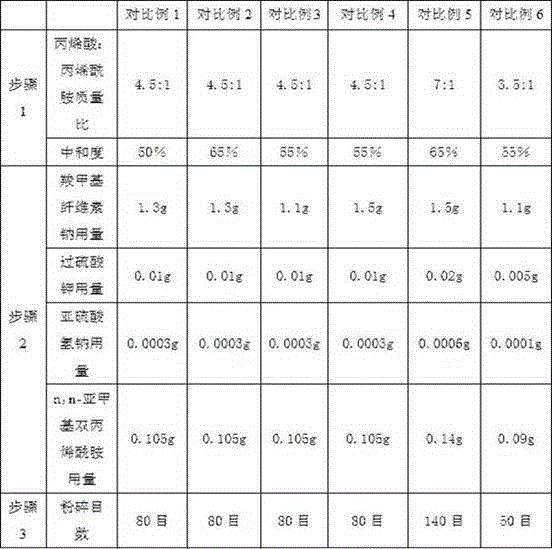A kind of biological hemostatic material and its preparation method and application
The technology of hemostatic dressing and graft is applied in the field of medicine, which can solve the problems of injury and wound temperature rise, and achieve the effects of convenient operation, no temperature rise and stable performance.
- Summary
- Abstract
- Description
- Claims
- Application Information
AI Technical Summary
Problems solved by technology
Method used
Image
Examples
Embodiment 1
[0027] The preparation of embodiment 1 acrylic resin graft
[0028] (1) Put a total of 15g of polymerized monomer acrylic acid and acrylamide (the mass ratio of acrylic acid:acrylamide is 4.5:1) in the reaction kettle, stir, and add 25% sodium hydroxide solution dropwise until the neutralization degree is 55%, to obtain the polymerization solution;
[0029] (2) Add 1.3g of pre-weighed sodium carboxymethylcellulose, 0.01g of potassium persulfate (initiator), 0.0003g of sodium bisulfite (initiator) and 0.105g of n,n-methylenebisacrylamide (Add in the form of aqueous solution, the concentration is 1g / L), microwave heating and stirring, carry out graft copolymerization reaction, the reaction temperature is 60-70 ℃, the reaction time is 2.5 hours, when the liquid is viscous, transfer it to the tray;
[0030] (3) Put the tray containing the pre-polymer into the oven quickly, polymerize and dry at 100-120°C, and after complete drying, crush it into 80-mesh particles and sieve. Afte...
Embodiment 2
[0031] The preparation of embodiment 2 acrylic resin grafts
[0032] (1) Put a total of 15g of polymerized monomer acrylic acid and acrylamide (the mass ratio of acrylic acid:acrylamide is 6:1) in the reaction kettle, stir, and add 25% sodium hydroxide solution dropwise until the neutralization degree is 55%, to obtain the polymerization solution;
[0033] (2) Add 1.5g of pre-weighed sodium carboxymethylcellulose, 0.01g of potassium persulfate (initiator), 0.0003g of sodium bisulfite (initiator) and 0.12g of n,n-methylenebisacrylamide (Add in the form of aqueous solution, the concentration is 1g / L), microwave heating and stirring, carry out graft copolymerization reaction, the reaction temperature is 60-70 ℃, the reaction time is 2.5 hours, when the liquid is viscous, transfer it to the tray;
[0034] (3) Put the tray containing the pre-polymer into the oven quickly, polymerize and dry at 100-120°C, and after complete drying, crush it into 100-mesh particles and sieve. After...
Embodiment 3
[0035] Embodiment 3 Comparative experiment of hemostatic effect
[0036] The acrylic resin prepared according to the method of the embodiment of the present invention and its grafts are compared with other comparative materials in terms of hemostasis time, blood loss, and 180-minute mortality, so as to determine the acrylic resin prepared according to the method of the embodiment of the present invention and its graft. Haemostatic effect of grafted hemostatic materials.
[0037] Experimental animals: 35 big-eared white rabbits, about half male and female, each weighing 2.5-3kg.
[0038] experimental method:
[0039] Big-eared white rabbits, about half male and female, were randomly divided into blank control group, pressurized bandaging group and drug treatment group. The weight of the dressing used in each drug treatment group was the same, 10 g, 10 rabbits in each group, and each experimental group was weighed before and after the experiment. The weight of the rabbit and t...
PUM
| Property | Measurement | Unit |
|---|---|---|
| particle size | aaaaa | aaaaa |
Abstract
Description
Claims
Application Information
 Login to View More
Login to View More - R&D
- Intellectual Property
- Life Sciences
- Materials
- Tech Scout
- Unparalleled Data Quality
- Higher Quality Content
- 60% Fewer Hallucinations
Browse by: Latest US Patents, China's latest patents, Technical Efficacy Thesaurus, Application Domain, Technology Topic, Popular Technical Reports.
© 2025 PatSnap. All rights reserved.Legal|Privacy policy|Modern Slavery Act Transparency Statement|Sitemap|About US| Contact US: help@patsnap.com

